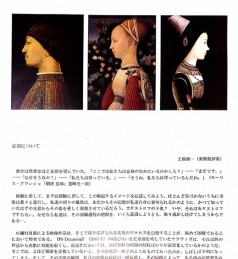
Leaflet_TAP 2005 Satellite Gallery
Leaflet
TAP 2005 Satellite Gallery
July 8, 2005
Oblivion -by art critic, Seiichi TSUCHIYA
Publisher: Toride Art Project 2005 Executive Committee, Writer: Seiichi TSUCHIYA (Art Critic)
She had an unusual desire for oblivion. 'I wonder if we're in oblivion here?' - ’Not yet.’ - ‘Why is that so?’ - ‘We're waiting.’ - ‘Yes, we are. We're waiting.’ (by Maurice Blanchot “L'Attente, l'oubli”)
I will start by describing this succession of images, first in the context of experience. Almost imperceptibly, things progress steadily, and the landscape around us is markedly altered in its appearance from what we once knew, as if the memories are betrayed by us. A sign of catastrophe? No, it's not even a catastrophe. Because no matter how conscious we are, we keep losing sight of the process of the collapse.
The video work by Mami Kosemura is unique, in that it is extremely difficult to follow the process of change that takes place there. The narrative, which was still lingering in “Decaying (2001)” gradually faded away, and in her recent works, it seems that the persistence of pure time is in the foreground a lot. Unless you are paying close attention to the picture, you might miss the changes. And in that moment of unknowing, the persistence of our experience gets short-circuited for a moment, and the short-circuiting can even give us a kind of amnesiac feeling. However, even if you continue to stare at the screen without blinking, many of us will experience a similar sensation. For example, the minute lapse between the beginning and the end of fresh raw life can be overlooked since the gap inbetween is too intense.
This oblivion may be due to a technique called animation, which is the principle that constitutes the image by Kosemura. The persistence in Kosemura's work is a false persistence, which is made up of a montage of fragments of the change, taken one at a time, for up to four months, as is often the case in high-speed photography. The animation in this collection, composed of still images, is made by shortening the time between shots. Even more, we could say that the shortened time is exactly the time that has been lost. Our impossible desire to sense lost or forgotten time between shots does not allow us to remember the false montaged duration of time. A sense of oblivion also exists deep inside the form of animation.
In "Portrait of It" (2004), a motif extracted from a Renaissance court profile portrait, Kosemura’s work comes to life with the repetitive blinking or slight lip movements that can only be seen upon close inspection. Staring into the unknown, unaware of our presence, a sense of longing can be felt, as we recognize the impossibility of exchanging even a slight glance. The slight movements bring on a feeling of amnesia. To understand this feeling, one need only look at the next exception to this work, which is based on a portrait by Masaccio. The portrait seems to be trying to connect its gaze to the viewer's in order to understand the other, or to turn its body towards the viewer. However, in the process of turning its head, the image begins to fade, and then it finally returns to its original profile. It is important here to note that the part of the face that begins to fade is the “eyes”. Isn't the eye the organ responsible for the memory of images as opposed to oblivion? Might the dissolution of the eye be an invitation to forget those images and consign them to oblivion?
What are the possibilities of oblivion in art? Describing the experience gained from the object is done by reconstructing the obtained memories afterwards. However, the reconstructed experience is only that which has gone through linguistic mediation. If there can be unmediated experiences that are not mediated by memory, this can only be done by actively forgetting, not simply by not remembering.This is nothing special. Isn't art something that is composed separately from our memory in the first place? However, it is not a denial of our experience, but rather an image of an intermediary experience, which comes only in oblivion, and given that we encounter each other, our encounter is forgotten. It creates what is meant to be a continuous, full experience, without intermediaries.
忘却について
土屋誠一(美術批評家)
彼女は異常なほど忘却を望んでいた。「ここでは私たちは忘却の中にいるのかしら?」ー「まだです。」ー「なぜそうなの?」ー「私たちは待っている。」ー「そうね。私たちは待っているんだわ。」(モーリス・ブランショ「期待 忘却」豊崎光一訳)
経験に即して、まずは経験に即して、この継起するイメージを記述してみよう。ほとんど気付かないうちに事態は着々と進行し、私達の周りの風景は、あたかもその記憶が私達自身に裏切られるかのように、かつて知っていたはずの光景からその姿を著しく変貌させているだろう。カタストロフの予兆? いや、それはカタストロフですらない。なぜなら私達は、その崩壊家庭の把握を、いくら意識しようとも、取り逃がし続けてしまうからである・・・。
小瀬村真美による映像作品は、そこで繰り広げられる変化のプロセスを記憶することが、極めて困難である点において特異である。《朽 - Decaying - 》(2001年) の頃にはいまだ余韻を残していたナラティヴは、それ以降の作品からは次第に気配を弱くし、最近作においては、ほぼ純粋な時間の持続ばかりが前景化しているかのようだ。そこでは、よほど画面を注視していないと、その変化が一体どのようなものであったのか、しばしば不明になってしまう。そして、その不明の瞬間、私達の経験の持続が一瞬短絡し、その短絡によって、ある種の記憶喪失のような感覚を与えられさえする。しかし仮に、瞬きもせずじっと画面を見続けたとしても、多くは同様の感覚に陥ることであろう。例えば、瑞々しい生の頂点を始点と終点とを結ぶ微細な経過は、始めと終わりのギャップがあまりにも強烈であるがゆえに、忘却されてしまう。
この忘却は、小瀬村によるイメージを構成する原理である、アニメーションという技法故の事であるかもしれない。小瀬村の作品における持続は、最大4ヶ月に渡る期間、間隔をあけて1枚づつ採取された変化の断片をー高速度撮影によくあるようにーモンタージュした、偽の持続である。この静止画の寄せ集めによって構成されるアニメーションは、いわば、ショットとショットの間にある時間を間引くことによって成り立つ。そして、その間引かれた時間こそが、忘却された時間であると指し示すことができるだろう。忘却された時間を、ショットとショットの間に感知しようとする私達の不可能な欲求は、モンタージュされた偽の時間的持続を、記憶に止めることを許さない。忘却は、アニメーションという形式の内部にも、深く折り畳まれている。
ルネサンスの宮廷肖像画から、プロフィールのものがモティーフとして抽出された《氏の肖像画》(2004年)では、微細な瞬きや、何かを呟いているかのような唇の所作のみが、間歇的に繰返される。所作が加えられることによって、永遠のモニュメントとしての肖像から、血の通う生の人間へと甦生したかのように見えるが、他者の視線の存在にあたかも気づいていないと思わせる没我の眼差しは、決して私達と視線を交わすことがない。この没我の所作は、まさに記憶喪失に等しい。このことを理解するためには、この作品における次にあげる例外、マサッチョ作とされる肖像画に基づくそれを見ればよい。その肖像は他を理解するために、観者に対して視線を結ぼうとしているのか、じりじりとその身を正面に向けようとする。しかしながら、身を向ける途中で断念するかのように、その像は溶解を始め、仕舞には元通りのプロフィールへと回帰するのだ。ここで注目すべきは、溶解し始める顔の部位が、「眼」であるということだ。目はまさに、忘却に対抗する、イメージの記憶を担う器官ではなかったか。この眼の溶解とは、イメージを記憶することを拒否し、私達に忘却せよと指示することの誘いではないだろうか。
美術における忘却とは、いかなる可能性を持ちうるのか。客体から得る経験を記述することは、得られた記憶を事後的に再構成することによってなされるであろう。しかしながら、再構成された経験は、言語的媒介を経たそれでしかない。もし記憶を媒介としない経験があり得るならば、それは単に記憶をしないことではなく、積極的に忘却してしまうことによってのみ可能になる。これは何ら特殊な事態ではない。芸術作品とは、そもそも私達の記憶に依存することはなく、それとは別箇に構成されたイメージではなかったか。ただしそれは、私達の経験を拒否するものではなく、むしろ忘却することにおいてのみ到来する、無媒介的な経験であるイメージと私達との遭遇は、互いに忘れてしまうことを所与として、媒介なしの、ある持続的な経験の充溢というべきものを、生成するのである。
__________
*Translators of this article
Yuki Matsumura, Masha Bogushevsky (https://www.befluentnyc.com)